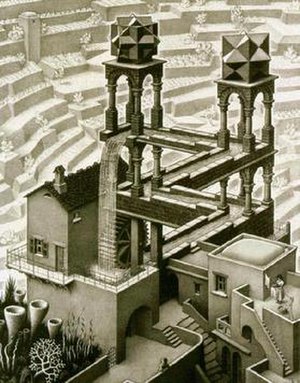M. C. Escher
Maurits Cornelis Escher
June 17th, 1898-March 27th 1972
Schooling
In Arnhem, he attended primary and secondary school from 1903-1918. When he failed the second grade, he was put into a special school for the sickly and disabled, as he was so. His grades weren't the greatest, but he completely excelled in the arts and drawing.
In 1919, he went ot the Haarlem School of Architecture and Decorative Arts. He failed a number of subjects, mostly due to his persistent skin infection. He briefly studied Architecture, but he didn't like it too much, and switched to Decorative Arts. In 1922 he left school, as he felt he had gained enough experience in making woodcuts and drawing.
His first experience with mathematics began with George Polya's paper on plane symmetry groups. This would inspire many works of Escher's. He never had any formal schooling/training with mathematics. If you'd like to read more about what the plane symmetry groups are, here's a good article!: [Link]
The Art!
The first graphic work that M.C. Escher created that was really praised was a linoleum cut in purple of his father in 1916. Escher's beginning work was mostly landscapes and very real, slightly bland images. He then went on a trip through Italy and France, and got a chance to look at all the ancient AND modern architecture. He wanted to improve on the artwork of the Moors, and that's where he got the idea to start most of his work with a geometric grid as a base. His interest in architecture came back, and to put a twist on it, he wanted to make it all funky! He began to drawing images of Italian architecture binding and turning and going all off what the planes in real life looked like, sometimes this is referred to as "mental imagery". He was also fascinated with 3-dimensional shapes like the Penrose Triangle and the Necker Cube.
So I'll show you some of this artwork that features tesselations, infinity, and "mental imagery"!:
"Waterfall"
"Sky and Water I"
"Day and Night"
"Symmetry No. 45"
WHAT DO WE GET FROM THIS, CLASS?
He was a cool guy with interesting ideas. Some quotes about his own work:
-"I think I have never yet done any work with the aim of symbolizing a particular idea, but the fact that a symbol is sometimes discovered or remarked upon is valuable for me because it makes it easier to accept the inexplicable nature of my hobbies, which constantly preoccupy me."
-"I try in my prints to testify that we live in a beautiful and orderly world, not in a chaos without norms, even though that is how it sometimes appears. My subjects are also often playful: I cannot refrain from demonstrating the nonsensicalness of some of what we take to be irrefutable certainties. It is, for example, a pleasure to deliberately mix together objects of two and three dimensions, surface and spatial relationships, and to make fun of gravity."





No comments:
Post a Comment